Spilker 10e Chapter 06 TB PDF

| Title | Spilker 10e Chapter 06 TB |
|---|---|
| Course | Federal Income Tax-Individual |
| Institution | University of Houston |
| Pages | 17 |
| File Size | 155.7 KB |
| File Type | |
| Total Downloads | 49 |
| Total Views | 137 |
Summary
McGraw-Hill's Taxation of Individuals and Business Entities 2019, 10e (Spilker)
Chapter 6 An Introduction to Tax...
Description
McGraw-Hill's Taxation of Individuals and Business Entities 2019, 10e (Spilker) Chapter 6 Individual Deductions 1) The profit motive distinguishes "business" activities from "personal" activities. 2) All business expense deductions are claimed as "below the line" deductions. 3) All investment expenses are itemized deductions. 4) Rental or royalty expenses are deductible "for" AGI. 5) To be deductible, business expenses must be directly related to a business activity. 6) The phrase "ordinary and necessary" means that an expense must be appropriate and helpful for generating a profit. 7) All reasonable moving expenses are deductible by employees. 8) Self-employed taxpayers can deduct the cost of health insurance as a "for" AGI deduction as long as they do not actually participate in their spouses' employer-provided health plan. 9) Self-employed taxpayers can choose between claiming a deduction or a credit for the employer portion of self-employment taxes paid. 10) An individual who forfeits a penalty for prematurely withdrawing a certificate of deposit (CD) is allowed to net the penalty against the interest income from the CD. 11) Excess business losses are carried back and then forward as net operating losses. 12) For married taxpayers filing separate, excess business losses are defined as aggregate business deductions over the sum of aggregate business gross income or gain of the taxpayer plus $250,000. 13) Qualified education expenses for purposes of the deduction of interest on educational loans are expenses paid for the education of the taxpayer, the taxpayer's spouse, or a taxpayer's dependent to attend a post-secondary institution of higher education. 14) The medical expense deduction is designed to provide relief for doctors and medical practitioners. 15) Deductible medical expenses include payments to medical care providers such as doctors, dentists, and nurses and medical care facilities such as hospitals. 16) Taxpayers traveling for the primary purpose of receiving essential and deductible medical care may deduct the cost of travel. 1 Copyright 2019 © McGraw-Hill Education. All rights reserved. No reproduction or distribution without the prior written consent of McGraw-Hill Education.
17) The deduction for medical expenses is limited to the amount of unreimbursed qualifying medical expenses paid during the year reduced by two percent of the taxpayer's AGI. 18) The itemized deduction for taxes includes all types of state, local, and foreign taxes. 19) Taxpayers may elect to deduct state and local sales taxes instead of deducting state and local income taxes. 20) Taxpayers are allowed to deduct mortgage interest on up to $1,000,000 of acquisition debt for their qualified residence for acquisition debt incurred after December 15, 2017. 21) The deduction for investment interest in excess of the net investment income carries forward to the subsequent year. 22) To qualify as a charitable deduction the donation must be made by cash or by check. 23) In general, taxpayers are allowed to deduct the fair market value of long-term capital gain property on the date of the donation to a qualified charitable organization. 24) The deduction to individual taxpayers for charitable contributions paid in cash made to public charities is limited to ten percent of the taxpayer's AGI. 25) Unreimbursed employee business expenses and hobby expenses are not deductible. 26) Bunching itemized deductions is one form of tax evasion. 27) Taxpayers generally deduct the lesser of their standard deduction or their itemized deductions. 28) Taxpayers filing single and taxpayers filing married separate have the same basic standard deduction amount. 29) An individual who is eligible to be claimed as a dependent on another's return and has $1,000 of earned income may claim a standard deduction of $1,350. 30) Generally, service businesses are considered qualified trade or businesses for purposes of the deduction for qualified business income. 31) Congress allows self-employed taxpayers to deduct the cost of health insurance above the line (for AGI) because: A) employers are allowed to deduct social security (FICA) taxes as a business expense. B) self-employed taxpayers need an alternate mechanism for reducing the cost of health care. C) this deduction provides a measure of equity between employees and the self-employed. D) health insurance premiums cannot be deducted otherwise. E) None of the choices are correct. 2 Copyright 2019 © McGraw-Hill Education. All rights reserved. No reproduction or distribution without the prior written consent of McGraw-Hill Education.
32) Which of the following is a true statement? A) Congress allows self-employed taxpayers to deduct the employer portion of their selfemployment tax. B) To deduct expenses associated with any profit motivated activity, taxpayers must maintain a high level of involvement or effort in the activity throughout the year. C) Business activities never require a relatively high level of involvement or effort from the taxpayer. D) All business expenses are deducted for AGI. E) All of the choices are correct. 33) Which of the following is a true statement? A) Unreimbursed employee business expenses are not deductible. B) Investment advisory expenses are not deductible. C) Business deductions are one of the most common deductions for AGI but they are not readily visible on the front of Form 1040. D) The distinction between business and investment expenses is critical for determining whether a deduction is claimed above the line (for AGI) or below the line (itemized). E) All of the choices are correct. 34) Which of the following is a true statement? A) Employee business expenses are deducted for AGI. B) Investment expenses are typically deducted for AGI. C) Tax preparation fees are deducted for AGI. D) Rental and royalty expenses are deducted for AGI. E) All of the choices are correct. 35) Which of the following is a true statement? A) Individuals qualify for the moving expense deduction only if they change employers. B) Individuals qualify for the moving expense deduction if their employer does not pay for the moving expenses. C) Moving expenses are deductible from AGI. D) Moving expenses are generally not deductible. E) Moving expenses are deductible for AGI. 36) Which of the following is a true statement? A) The deduction for interest on educational loans is subject to a phase-out limitation. B) The deduction for moving expenses is subject to a phase-out limitation. C) Self-employed taxpayers are allowed to deduct health care premiums even if the taxpayer is eligible to participate in an employer-provided health plan. D) Excess business losses are deductible up to $100,000. E) All of the choices are false.
3 Copyright 2019 © McGraw-Hill Education. All rights reserved. No reproduction or distribution without the prior written consent of McGraw-Hill Education.
37) Which of the following is a true statement? A) For purposes of the deduction for educational interest, an educational loan must be used to pay tuition to any type of school. B) The maximum deduction for educational interest is $5,000 for married taxpayers filing jointly. C) Self-employed taxpayers are not allowed to deduct health care premiums if the taxpayer is eligible to participate in their spouse's employer-provided health plan. D) Self-employment taxes paid by self-employed taxpayers are deductible as business expenses. E) All of the choices are correct. 38) Which of the following is a true statement? A) For purposes of the deduction for educational interest, expenses do not include expenses for room, board and travel. B) For purposes of the deduction for educational interest, qualified education expenses are those paid for the education of the taxpayer, the taxpayer's spouse, or a taxpayer's dependent. C) The maximum deduction for interest expense on qualified education loans is $6,000. D) A penalty paid for prematurely withdrawing a certificate of deposit or similar deposit is deductible from AGI as an investment expense. E) All of the choices are false. 39) This year, Jong paid $3,000 of interest on a qualified education loan. Jong files married filing joint and reports modified AGI of $147,000. What is Jong's deduction for interest expense on an educational loan? A) $2,500. B) $3,000. C) $1,500. D) $1,000. E) None of the choices are correct. 40) Mason paid $4,100 of interest on a loan that paid tuition for him to attend a private university this year. How much of this payment can Mason deduct as interest expense on an educational loan if he files single and reports modified AGI of $90,000? A) $4,100. B) $4,000. C) $2,667. D) $2,000. E) None of the choices are correct. 41) This year Riley files single and reports modified AGI of $71,000. Riley paid $1,200 of interest on a qualified education loan. What amounts can Riley deduct for qualifying education interest? A) The deduction for qualifying education interest is $1,200. B) The deduction for qualifying education interest is $1,000. C) The deduction for qualifying education interest is $720. D) The deduction for qualifying education interest is $200. E) None of the choices are correct. 42) Max, a single taxpayer, has a $270,000 loss from his sole proprietorship. How much of this 4 Copyright 2019 © McGraw-Hill Education. All rights reserved. No reproduction or distribution without the prior written consent of McGraw-Hill Education.
loss is deductible after considering the excess business loss rules? A) $270,000. B) $250,000. C) $20,000. D) $0. E) None of the choices are correct. 43) Max, a single taxpayer, has a $270,000 loss from his sole proprietorship. How much of this loss is not deductible after considering the excess business loss rules? A) $270,000. B) $250,000. C) $20,000. D) $0. E) None of the choices are correct. 44) Han is a self-employed carpenter and his wife, Christine, works full-time as a grade school teacher. Han paid $525 for carpentry tools and supplies, and Christine paid $3,600 as her share of health insurance premiums (not with pre-tax dollars) for Han and herself in a qualified plan provided by the school district (not through an exchange). Which of the following is a true statement? A) The tools and supplies are deductible for AGI while the health insurance is an itemized deduction. B) Both expenditures are deductible for AGI. C) The tools and supplies are an itemized deduction but the health insurance is deductible for AGI. D) Both expenditures are itemized deductions. E) Neither of the expenditures is deductible. 45) Bruce is employed as an executive and his wife, Marie, is a self-employed realtor. Besides Bruce's salary, Bruce and Marie own a warehouse that they rent to a local business for storage. This year they paid $1,250 for electric service in the warehouse. Marie also paid selfemployment tax of $6,200 and Bruce had $7,000 of Social Security taxes withheld from his pay. Marie paid $45 fee to rent a safe deposit box to store records associated with her realty operation. Which of the following is a true statement? A) One-half of the social security tax is deductible for AGI. B) Only the electric bill is deductible for AGI. C) The self-employment tax is not deductible. D) The safe deposit fee and the electric bill are deductible for AGI. E) None of the choices are correct.
5 Copyright 2019 © McGraw-Hill Education. All rights reserved. No reproduction or distribution without the prior written consent of McGraw-Hill Education.
46) Brice is a single, self-employed electrician who earns $60,000 per year in self-employment income. Brice paid the following expenses this year. Which of the expenses are deductible for AGI? 1. The cost of health insurance (not purchased through an exchange) 2. The employer portion of self-employment tax paid 3. Penalty on early withdrawal of funds from a certificate of deposit A) Numbers 1 and 2 only. B) Numbers 1 and 3 only. C) Numbers 2 and 3 only. D) None of the choices is deductible for AGI. E) All of the choices are deductible for AGI. 47) Hector is a married self-employed taxpayer, and this year he paid $3,000 for his health insurance premiums (not through an exchange). Under which of the following alternative conditions can Hector deduct the cost of the premiums for AGI? A) Hector chose not to participate in the employer-sponsored plan of his spouse. B) Hector's spouse participates in an employer-sponsored plan but Hector is not eligible to participate in this plan. C) Neither Hector nor his spouse participates in an employer-sponsored plan although both are eligible to participate in a plan. D) Hector can deduct the health insurance premiums regardless of the insurance status of his spouse. E) None of the choices – health insurance premiums can only be deducted as an itemized deduction. 48) Lewis is an unmarried law student at State University, a qualified educational institution. Last year Lewis borrowed $30,000 and used the proceeds to pay his university tuition. This year Lewis paid $1,500 of interest on the loan. Which of the following is a true statement if Lewis reports $40,000 of salary and no other items of income or expense? A) Lewis can deduct all the interest on his student loan for AGI. B) Lewis can deduct all the interest on his student loan as an itemized deduction. C) Lewis can only deduct $1,000 of the interest on his student loan for AGI. D) Lewis can only deduct $1,000 of the interest on his student loan as an itemized deduction. E) All of the choices are false.
6 Copyright 2019 © McGraw-Hill Education. All rights reserved. No reproduction or distribution without the prior written consent of McGraw-Hill Education.
49) This fall Millie finally repaid her student loan. She originally borrowed the money to pay tuition several years ago when she attended at State University (a qualified educational institution). This year Millie paid a total of $2,400 of interest on the loan. If Millie files single and reports $70,000 of income and no other items of income or expense how much of the interest can she deduct? A) Millie can deduct $2,400 for AGI. B) Millie can deduct $1,600 for AGI. C) Millie can deduct $2,400 as an itemized deduction. D) Millie can deduct $800 for AGI. E) None - the tuition is not deductible. 50) Ned is a head of household with a dependent son, Todd, who is a full-time student. This year Ned made the following expenditures related to Todd's support:
Auto insurance premiums Room and board at Todd's school Health insurance premiums (not through an exchange)
$1,700 2,200 600
Travel (to and from school)
350
What amount can Ned include in his itemized deductions? A) $1,700 included in Ned's miscellaneous itemized deductions. B) $2,050 included in Ned's miscellaneous itemized deductions. C) $950 included in Ned's miscellaneous itemized deductions. D) $600 included in Ned's medical expenses. E) None of the choices are correct. 51) Which of the following is a true statement? A) A taxpayer can deduct medical expenses incurred for members of his family who are dependents. B) A taxpayer can deduct medical expenses incurred for a qualified relative even if the relative does not meet the gross income test. C) A divorced taxpayer can deduct medical expenses incurred for a child even if the child is claimed as a dependent by the former spouse. D) Deductible medical expenses include long-term care services for disabled spouses and dependents. E) All of the choices are true. 52) Which of the following costs are deductible as an itemized medical expense? A) The cost of prescription medicine and over-the-counter drugs. B) Medical expenses incurred to prevent disease. C) The cost of elective cosmetic surgery. D) Medical expenses reimbursed by health insurance. E) None of the above costs is deductible. 7 Copyright 2019 © McGraw-Hill Education. All rights reserved. No reproduction or distribution without the prior written consent of McGraw-Hill Education.
53) Which of the following costs are NOT deductible as an itemized medical expense? A) The cost of eyeglasses. B) Payments to a hospital. C) Transportation for medical purposes. D) The cost of insurance for long-term care services. E) All of the choices are deductible as medical expenses. 54) Opal fell on the ice and injured her hip this winter. As a result she paid $3,000 for a visit to the hospital emergency room and $750 for follow-up visits with her doctor. While she recuperated, Opal paid $500 for prescription medicine and $600 to a therapist for rehabilitation. Insurance reimbursed Opal $1,200 for these expenses. What is the amount of Opal's qualifying medical expense? A) $3,000. B) $3,750. C) $3,650. D) $4,850. E) All of the choices are correct. 55) Which of the following taxes will not qualify as an itemized deduction? A) Personal property taxes assessed on the value of specific property. B) State, local, and foreign income taxes. C) Real estate taxes on a residence. D) Gasoline taxes on personal travel. E) None of the choices qualify as an itemized deduction. 56) This year Amanda paid $749 in Federal gift taxes on a gratuitous transfer to her nephew. Amanda lives in Texas and does not pay any state or local income taxes. Which of the following is a true statement? A) Amanda cannot deduct Federal gift taxes. B) Amanda can deduct Federal gift taxes for AGI. C) Amanda can deduct Federal gift taxes paid as an itemized deduction. D) Amanda must include Federal gift taxes with other miscellaneous itemized deductions. E) None of the choices are true. 57) This year Norma, a single taxpayer, paid $11,200 of real estate taxes on her personal residence and 9,500 of state income taxes. Which of the following is a true? A) Norma can deduct $11,200 of real estate taxes as an itemized deduction. B) Norma can deduct $9,500 of state income taxes as a for AGI deduction. C) Norma can deduct $10,000 of taxes as an itemized deduction. D) Even if Norma has no other itemized deductions, she should claim the standard deduction. E) None of the choices are correct.
8 Copyright 2019 © McGraw-Hill Education. All rights reserved. No reproduction or distribution without the prior written consent of McGraw-Hill Education.
58) Madeoff donated stock (capital gain property) to a public charity. He purchased the stock 3 years ago for $100,000, and on the date of the gift, it had a fair market value of $200,000. What is his maximum charitable contribution deduction for the year related to this stock if his AGI is $500,000 (before considering the itemized deduction phase-out)? A) $100,000. B) $200,000. C) $150,000. D) $250,000. E) None of the choices are correct. 59) Carly donated inventory (ordinary income property) to a church. She purchased the inventory last month for $100,000, and on the date of the gift, it had a fair market value of $92,000. What is her maximum charitable contribution deduction for the year related to this inventory if her AGI is $200,000? A) $100,000. B) $92,000. C) $60,000. D) $46,000 if the church sells the inventory. E) None of the choices are correct. 60) Simone donated a landscape painting (tangible capital gain property) to a library, a public charity. She purchased the painting five years ago for $50,000, and on the date of the gift, it had a fair market value of $200,000. What is her maximum charitable contribution deduction for the year if her AGI is $300,000 (before considering the itemized deduction phase-out)? A) $100,000. B) $200,000. C) $90,000 if the library uses the painting in its charitable purpose. D) $150,000. E) None of the choices are correct. 61) Larry recorded the following donations this year: $500 cash to a family in need $2,400 to a church $500 cash to a political campaign To the Salvation Army household items that originally cost $1,200 but are worth $300. What is Larry's maximum allowable charitable contribution if his AGI is $60,000? A) $2,900. B) $1,000. C) $2,700. D) $4,600. E) None of the choices are correct.
9 Copyright 2019 © McGraw-Hill Education. All rights reserved. No reproduction or distribution without the prior written consent of McGraw-Hill Education.
62) Which of the following is a true statement? A) The deduction of cash contribution...
Similar Free PDFs

Spilker 10e Chapter 06 TB
- 17 Pages

Spilker 10e Chapter 04 TB
- 18 Pages

Spilker 10e Chapter 05 TB
- 21 Pages

Spilker 10e Chapter 01 TB
- 17 Pages

Spilker 10e Chapter 02 TB
- 16 Pages

Eun8e chapter 06 tb
- 21 Pages
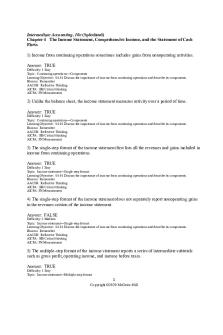
Spiceland 10e TB Chapter 04 Final
- 105 Pages

Spilker TIBE 10e Ch08 SM v3
- 65 Pages
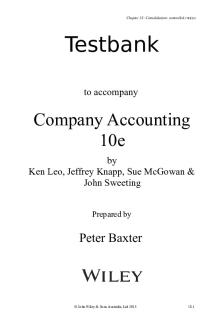
Ch18 tb leo 10e - Ch18 tb leo 10e
- 16 Pages
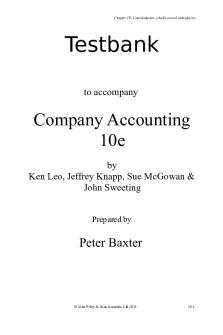
Ch19 tb leo 10e - Ch19 tb leo 10e
- 17 Pages
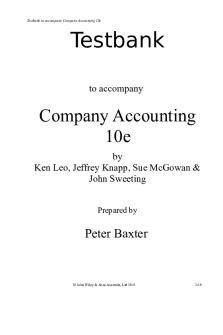
Ch24 tb leo 10e - Ch24 tb leo 10e
- 15 Pages

Eun8e chapter 06 tb answerkey
- 28 Pages
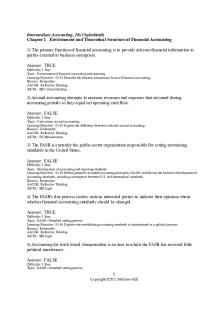
Spiceland 10e TB Chapter 01 Final
- 51 Pages
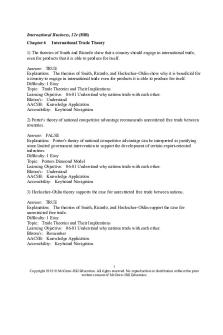
Hill12e Chapter 06 TB Answer Key
- 44 Pages
Popular Institutions
- Tinajero National High School - Annex
- Politeknik Caltex Riau
- Yokohama City University
- SGT University
- University of Al-Qadisiyah
- Divine Word College of Vigan
- Techniek College Rotterdam
- Universidade de Santiago
- Universiti Teknologi MARA Cawangan Johor Kampus Pasir Gudang
- Poltekkes Kemenkes Yogyakarta
- Baguio City National High School
- Colegio san marcos
- preparatoria uno
- Centro de Bachillerato Tecnológico Industrial y de Servicios No. 107
- Dalian Maritime University
- Quang Trung Secondary School
- Colegio Tecnológico en Informática
- Corporación Regional de Educación Superior
- Grupo CEDVA
- Dar Al Uloom University
- Centro de Estudios Preuniversitarios de la Universidad Nacional de Ingeniería
- 上智大学
- Aakash International School, Nuna Majara
- San Felipe Neri Catholic School
- Kang Chiao International School - New Taipei City
- Misamis Occidental National High School
- Institución Educativa Escuela Normal Juan Ladrilleros
- Kolehiyo ng Pantukan
- Batanes State College
- Instituto Continental
- Sekolah Menengah Kejuruan Kesehatan Kaltara (Tarakan)
- Colegio de La Inmaculada Concepcion - Cebu

